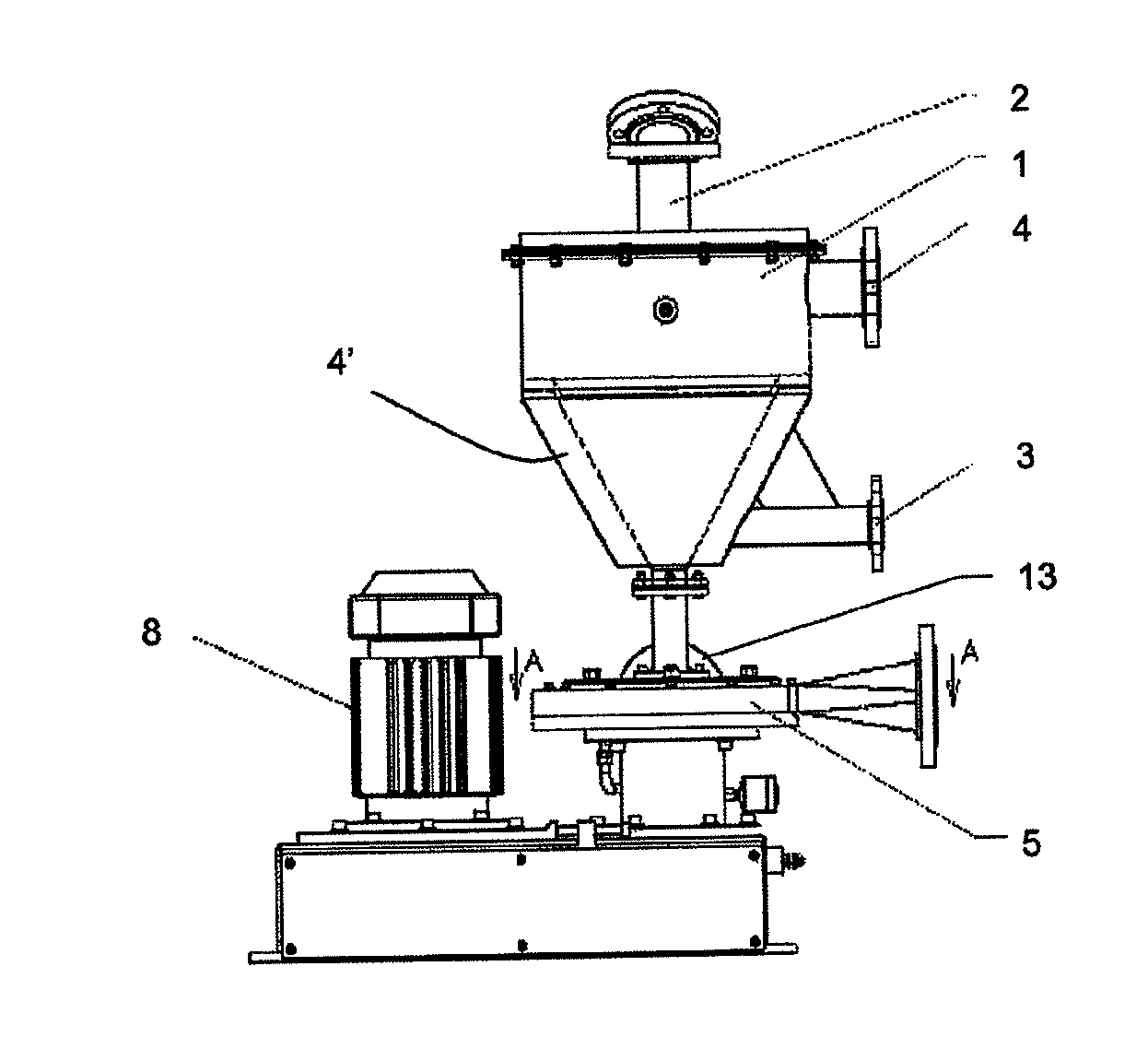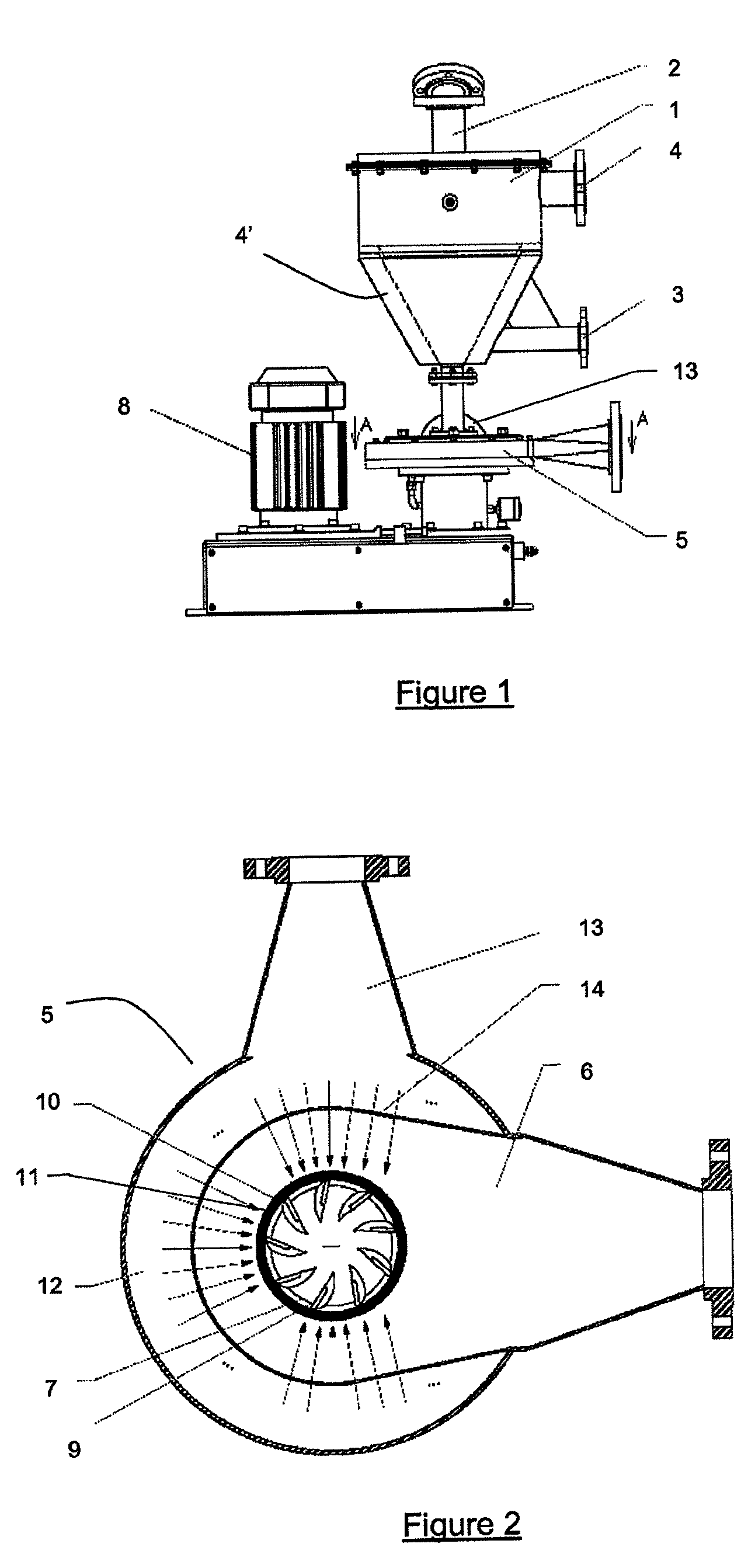Device for preparing a dispersion of water-soluble polymers in water, and method implementing the device
a technology of water-soluble polymers and water-soluble polymers, which is applied in the direction of dissolving, antibody medical ingredients, and dissolving with driven stirrers, etc., can solve the problems of high viscosity of the resulting solution, difficult dissolution of the polymer, and large rotor rotation speed, etc., to achieve the effect of reducing the speed of rotation of the rotor
- Summary
- Abstract
- Description
- Claims
- Application Information
AI Technical Summary
Benefits of technology
Problems solved by technology
Method used
Image
Examples
example 1
The Device
[0075]According to FIG. 1, the device of the invention comprises:[0076]a wetting cone (1) connected at its apex to a column (2) batching the standard grain size distribution polymer, usually via a metering screw, the cone (1) being connected at its bottom to a primary water inlet circuit (3) which feeds an overflow (4, 4′),[0077]at the bottom end of the cone, an assembly (5) comprising:[0078]a chamber (6) for grinding and draining of the dispersed polymer (FIG. 2) comprising:[0079]a rotor (7) driven by a motor (8) fitted with knives (9),[0080]a fixed stator (10) comprising blades (11) uniformly spaced and slightly tilted with respect to the radius of the rotor,[0081]on all or part of the periphery of the chamber, a ring (12) fed by a secondary water circuit (13), the ring (12) communicating with the chamber (6) via slits (14) for spraying pressurised water on the blades (11) of the stator (10).
example 2
Application
[0082]Three grinding units according to the invention having different sizes were tested in this example.
[0083]The technical features and dissolution conditions are given in the table below using an acrylamide / sodium acrylate copolymer having a molecular weight of 19 million and grain size distribution of 0-1000 microns.
[0084]
Test 1Test 2Test 3‘PSU 300’‘PSU 100’‘PSU 1000’Technical features of thegrinding unitCutting diameter in mm (rotor200 100 400size)Number of fixed knives9050200Height of fixed knives in mm 16.6 16.6 33.2Spacing between knives300microns200microns400micronsSpacing between fixed / mobile100microns100microns100micronsknivesCutting angle3°2°3°Number of mobile knives (i.e.: on 6 4 12the rotor)Rotor speed3000rpm5000rpm2000rpmRotor power7.5kW3kW20kWDispersion characteristicsPrimary water flow rate10m3 / h3m3 / h20m3 / h25°C.25°C.25°C.Anionic polyacryl amide flow rate300kg / h110kg / h1400kg / h(anionicity 30%; molecular weight19 million; grain size distribution0-1000 mic...
PUM
| Property | Measurement | Unit |
|---|---|---|
| grain size distribution | aaaaa | aaaaa |
| grain size distribution | aaaaa | aaaaa |
| angle | aaaaa | aaaaa |
Abstract
Description
Claims
Application Information
 Login to View More
Login to View More - R&D
- Intellectual Property
- Life Sciences
- Materials
- Tech Scout
- Unparalleled Data Quality
- Higher Quality Content
- 60% Fewer Hallucinations
Browse by: Latest US Patents, China's latest patents, Technical Efficacy Thesaurus, Application Domain, Technology Topic, Popular Technical Reports.
© 2025 PatSnap. All rights reserved.Legal|Privacy policy|Modern Slavery Act Transparency Statement|Sitemap|About US| Contact US: help@patsnap.com


